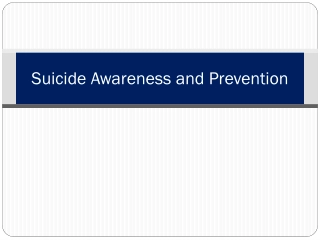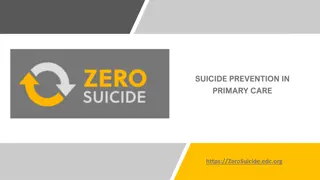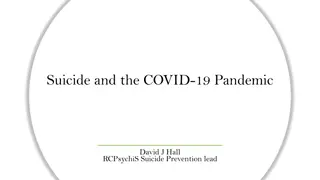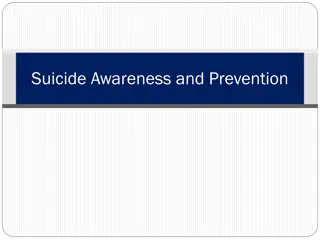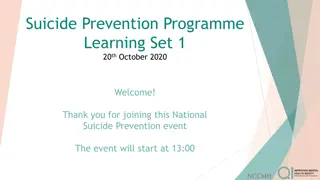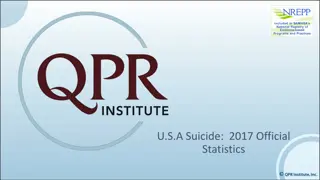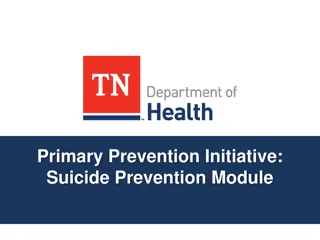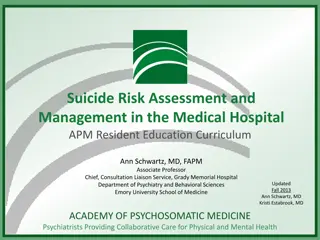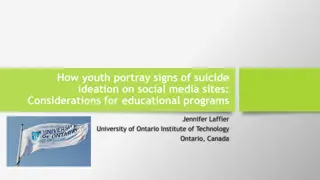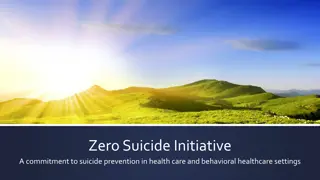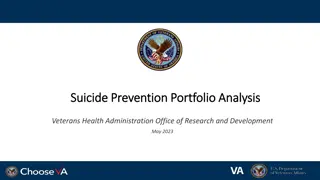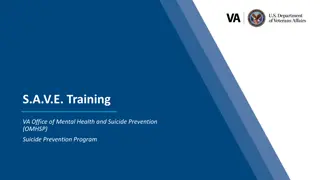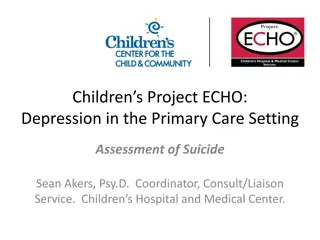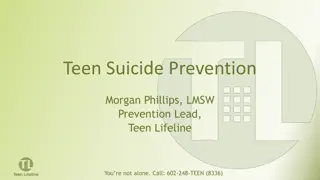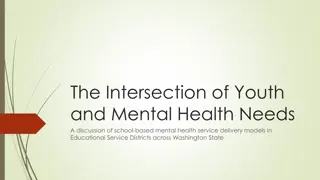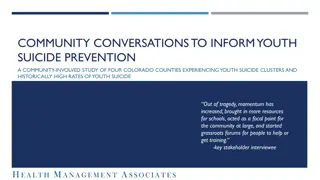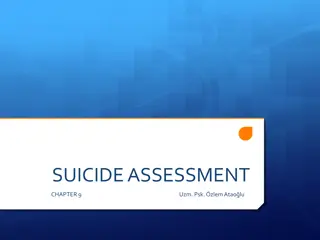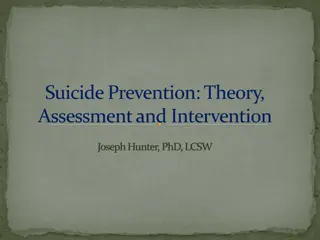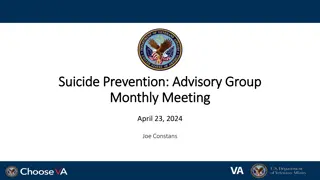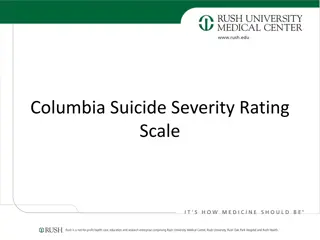
Understanding Suicide: Facts, Myths, Prevention, and Statistics
Explore beliefs, facts, and myths surrounding suicide, learn how to talk about suicide, recognize warning signs, and access resources for help. Discover suicide statistics, rates by age and gender, and the importance of prevention through open conversation. Addressing topics like suicide risk assessment and prevention, this content aims to raise awareness and provide valuable insights to help combat this global issue.
Download Presentation

Please find below an Image/Link to download the presentation.
The content on the website is provided AS IS for your information and personal use only. It may not be sold, licensed, or shared on other websites without obtaining consent from the author. If you encounter any issues during the download, it is possible that the publisher has removed the file from their server.
You are allowed to download the files provided on this website for personal or commercial use, subject to the condition that they are used lawfully. All files are the property of their respective owners.
The content on the website is provided AS IS for your information and personal use only. It may not be sold, licensed, or shared on other websites without obtaining consent from the author.
E N D
Presentation Transcript
1 TERAPIA MODULE 1 Suicide Risk Assessment and Prevention Module 1
Warning 2 This presentation content may trigger powerful emotions and aspects of the topic might not feel safe enough to discuss today There might be people who have close relationships with the subject; we need to be mindful of that aspect and take care of yourselves & colleagues
Today will cover 3 Beliefs about suicide How to talk about suicide The facts Warning signs and risk factors Basic intervention skills to use with suicidal behavior Resources for help The aftermath of suicidal behavior
Myths vs. Facts: True or False? 4 Talking openly about suicide will cause it. Anyone can learn to help someone who is struggling with thoughts of suicide. If someone decides that they want to take their own life, there s nothing we can do to stop them. If someone talks about suicide they don t need to be taken seriously. There are signs that we can look for that may indicate someone is considering suicide.
Our Words Reflect Our Beliefs 5 Preventing suicide starts with our comfort in acknowledging and talking about suicide
Suicide in UK 6 Total number of suicides 6211 deaths in 2020 a slight decrease from 2019 Rate in England 10 per 100,000 people Scotland highest rate in UK 15 per 100,000 people Estimated global rate 10.5 per 100,000 * Suicide rates for men and women In the UK, men are three times as likely to die by suicide than women. Estimated worldwide men 2.3 times more likely to die by suicide.* 6
7 Suicide rates by age and gender In the UK, the highest suicide rate is among men aged 45-49. In the Republic of Ireland, the highest rate is among men aged 55-65. UK: rising suicide rates in under-25s The rate of deaths among under 25s increased by 23.7%, reaching 730 deaths in 2018. UK: rising suicide rates in middle-aged men Men aged 45-49 still have the highest rate of suicides. In 2020: 23.8 per 100,000
Attempted Suicides 8 Suicide Attempted Suicides
Non-Suicidal Self-Injury 9 Distinct from suicidal intent, however Those who self-injure are at higher risk for suicidal behavior Reasons for Self-Injury are many: o Release of tension and anxiety o Physical pain versus emotional pain o Euphoria; Brain chemistry o Self punishment o To affect change in others
Warning Signs Risk Factors , Protective Factors Risk Factors- Stressful events or situations that may increase the likelihood of a suicide attempt or death. (Not predictive!) 10 Protective Factors- Personal and social resources that promote resiliency and reduce the potential of suicide and other high-risk behaviors. Warning Signs- the early observable signs that indicate increased risk of suicide for someone in the near-term. (Within hours or days.)
Long Term (Unchanging) Long Term (Modifiable) Triggers Risk Factors 11 Family history of: Suicide Mental illness Substance abuse Race Gender Major family conflict Exposure to suicide of family member Anniversary of death Moving often Unrealistic parental Family expectations Abuse (emotional, physical, sexual) Previous suicide attempt Extreme perfectionism Rejection Personal Behavioral Relationship break-up Lossthrough death, Mental illness Current acute mental abandonment, divorce Substance abuse illness Poor coping/social skills Severe stress/anxiety Impulsivity Isolation Increased use of substances Inconsistent, neglectful or abusive parenting Bullying, Harassment Arrest/Incarceration Social/ Chronic severe stress
LGBT Youth/Young Adults 12 LGBTQ suicide attempt rates 3-4 times their peers Critical risk factors include: rejection, depression, anxiety, chronic stress, Victimization: abuse, bullying, etc Rejection by family can increase risk up to 8X Family acceptance and school safety are strong protective factors Cultural competence in school and provider community goes a long way
Men as a High Risk Group 13 Gender disparity highest in elders Gender issues include: Poor help-seeking Men less likely to talk to someone when in crisis Difficulty recognizing and expressing emotions Increased substance abuse Use more lethal means for attempts Feeling like a burden Struggle between belongingness and independence
Women and Suicide 14 Risk: Increased risk for depression Higher attempt rates, less deadly means Domestic violence, childhood abuse Pregnancy & parenthood-both risk and protective Protection: Increased verbal and social skills Increased help seeking behaviors Social networks, stronger connection to services Maintain a higher reported sense of relevance as they age
Suicide Risk in Military Veterans 15 Factors increasing risk: Age; the younger and older Severity of wounds/ hospitalization Frequent/extended deployments Physical/sexual assault while in military Active Substance abuse Risk heightened by: PTSD, Traumatic Brain Injury, Depression Pre-existing conditions Female veterans 18-34 die by suicide 6X non- veteran rate (U.S.A 2015)
16 Protective Factors across lifespan Skills to think, communicate, solve problems, manage anger and other negative emotions; coping skills Purpose & value in life; hope for the future, pets, work/ life focus, family connections and support; feeling of use in your world Personal characteristics- health and access to healthcare, positive outlook, healthy lifestyle choices, spirituality or religious belief Supports- family, friends, mentors, vocational and other caring connected people Safe Environment restricted access to lethal means; personal safety
Warning Signs THESE ARE CHANGES IN BEHAVIOR OR APPEARANCE THAT INDICATE SOMEONE IS IN CRISIS!
Clear Signs Of A Suicidal Crisis 18 1. Someone threatening to hurt or kill themselves 2. Someone looking for the means (gun, pills, rope etc.) to kill themselves; has a clear plan. 3. Someone showing signs of distress/ agitation/ anxiety Get the facts and take action! Call 999 if lethal means is present Call CrisisHotline if no means present
Warning Signs 19 Ideation / threatened or communicated Substance abuse / excessive or increased? Purposelessness / no reasons for living Anxiety /agitation / insomnia Trapped / feeling no way out Hopelessness / nothing will ever change Withdrawal from friends, family, society Anger (uncontrolled)/ rage / seeking revenge Recklessness/ risky acts / unthinking Mood changes (dramatic)
Adolescent Warning Signs for Suicide 20 Is the youth (up to age 20) : Talking about or making plans for suicide Expressing hopelessness about the future Displaying severe/overwhelming emotional pain or distress Showing worrisome behavior or changes particularly in the presence of the above warning signs. Specifically: o Withdrawal from or changes in social connections o Recent increased agitation or irritability o Anger or hostility that seems out of character or context o Changes in sleep (increased or decreased)
Suicide in the Young ( under 15 y.o.) 21 Warning Signs (very similar to previous list): Change in usual behavior School refusal Risky behavior Talk of intent to die Self harm (may be seen as recurrent accidents ) Verbal clues of suicidal thoughts Risk Factors: More than one mental health diagnosis & untreated MH concerns Early trauma or stressful events Negative school experience (bullying) Loss of early primary attachments (death, placement in foster care etc.) Internalizing distress vs. externalizing If a child mentions suicide (or not wanting to be around anymore)-take it seriously!!!!
Keep Your Eyes and Ears Open 22 Direct clues: Less Direct clues: Life s just too hard You d be better off without me What s the point? I wish I was dead I m going to end it all I m going to kill myself
From a Suicidal Persons Point of View 23 Crisis point has been reached Pain is unbearable Solutions to problems seem unavailable Thinking is affected HOWEVER: Ambivalence exists Communicating distress is common Invitations to help are often extended
24 Why People Hesitate to Ask for Help Unwilling to admit needing help Afraid to upset/anger others Unable describe their feelings/needs Unsure of available help or resources Struggling with symptoms of depression Don t know what to expect Shame, fear of stigma May prefer to confide in peers
Why People Hesitate to Help 25 Not sure about how severe the risk is; what if they re wrong? Worry about doing/saying the right thing Feelings of inadequacy Afraid to put the idea in someone s head Feel it s not their issue Bystander Effect
26 What IS Helpful 1) Show You Care Listen carefully Be genuine I m concerned about you . . . about how you feel. 2) Ask the Question Be direct, caring and non- confrontational Are you thinking about suicide? 3) Get Help Do not leave him/her alone You re not alone. Let me help you.
When to Call Crisis 27 Crisis clinicians are: Available 24 / 7 Clinicians can often come to your location for an assessment Call for a phone consult when you are: Concerned about someone s mental health Need advice about how to help someone in distress Worried about someone and need another opinion Call the Samaritans - call is free (116 123)
After a Suicide Attempt Initial focus is on safety Work to address reduction in crisis Safety planning for managing at home and in community For return to the community after a crisis: o Coordinate with and support the family o Who is the support person overseeing the transition o What do other people need to know o Offer hope and support o Encourage follow-through with treatment 28 Attend to the needs of other affected staff/ community members
Survivors of Suicide Loss 29 Struggle to make meaning of the loss Face a storm of questions and what ifs Suffer from overwhelmingly complicated feelings From deep sadness, to anger, to fear May take a long time to grieve Need understanding and support Youth survivors have special issues
30 How YOU Can Be Supportive After a Suicide Acknowledge the loss Use the name of the deceased Share your presence Share a special memory/story of their life Acknowledge the good things Stay in touch over time Recommend grief support counseling or support groups for survivors
Take Care of Yourself 31 Acknowledge the intensity of your feelings Seek support from colleagues, de-brief Share your feelings with family/friends Avoid over involvement Know that you are not responsible for another person s choice to end their life
Recommended reading 32 Freedenthal, S. (2017) Helping the Suicidal Person: Tips and Techniques for Professionals Jobes, D.A. (2018) Managing Suicidal Risk: A Collaborative Approach Shea, S.C. (2011) The Practical Art of Suicide Assessment: A Guide for Mental Health Professionals and Substance Abuse

